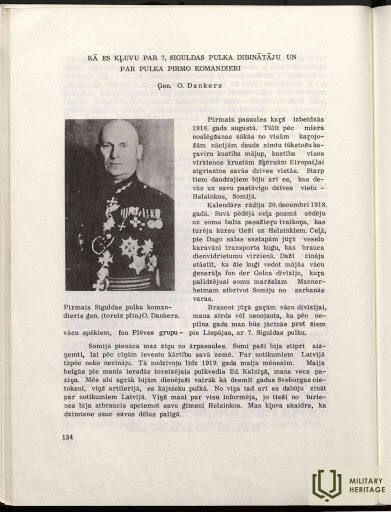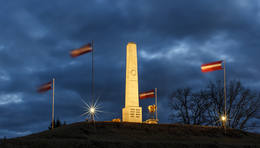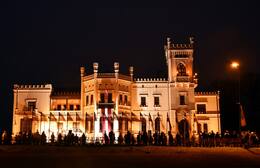7. Formation of the Sigulda Infantry Regiment
On June 20, 1919, the 7th Sigulda Infantry Regiment began to be formed in Naukšēni Manor, near Rūjiena, according to the order of the commander of the North Latvian Brigade, Colonel Jorģis Zemitāns. Initially, a small combat group consisting of 22 officers and 1,580 soldiers was formed from the reserve battalion of the North Latvian Brigade, which, in honor of its first commander Oskars Danker, was named the Danker Division. A few days later, the division was included in the 2nd Battalion of the 3rd Jelgava Regiment, and on August 23, with the addition of a company, it was included in the 7th Sigulda Infantry Regiment.
“In Tallinn, I looked for Colonel Zemitāns at his headquarters. In a small narrow street, I found the number I was looking for, according to the address given. A small piece of paper was pinned to the door, on which was written in ink: Headquarters of the Commander-in-Chief of the North Latvian Army. The gray surroundings and simplicity, not to say poverty, oppressed me. But then pride slowly awoke in me along with the thought that it was right to start small, because then you have the opportunity to grow up big and stately. After a short time, I was summoned to Rūjiena. There I met with Colonel Zemitāns’ chief of staff, General Voldemārs Ozolas. He informed me that it was urgent to send Latvian troops to Liepāja, at least in the strength of a regiment. The Commander-in-Chief of the North Latvian Army instructed me to form one infantry regiment from the Rūjiena reserve battalion and appointed me the commander of this regiment. V. Ozols wrote this order in a field notebook, and this little piece of paper was the basis for the formation of the regiment.”
Memories of Oskars Dankers. How I Became the Founder and First Commander of the 7th Sigulda Infantry Regiment. “In Memory of the Sigulda Regiment. 1919.20.-VI 1959.” Toronto: Sigulda Regiment Memorial Foundation, 1959, pp. 9-10.
Alūksne Museum
Related timeline
Related topics
Related objects
Monument to the soldiers of the 7th Sigulda Infantry Regiment who fell in the Latvian War of Independence
Located on the shore of Lake Alūksne, on the side of Pskevas Street (Kolberg Street).
On June 22, 1923, the President of Latvia, Jānis Čakste, unveiled a monument to the fallen soldiers of the 7th Sigulda Infantry Regiment. The monument was designed by artist Jūlijs Miesnieks.
The soldiers of the regiment also improved and maintained the area around the monument. The soldiers gathered at the monument on the eve of the regiment's anniversary celebration, when they lit the sacred fire, as well as on the day of the regiment's anniversary after the parade and intercession at the Garrison Cemetery.
In 1940/1941, the Bolsheviks removed and destroyed the plaque, but the monument itself was demolished in 1953 and its stones were built into the corner foundations of the barracks building.
As the Awakening began, the area around the destroyed monument, which was still located in the territory of the USSR occupation troops at the time, was cleaned up in the autumn of 1989. On November 11, a temporary granite memorial was unveiled at the former location of the monument, with the text engraved: "The monument to the 7th Sigulda Infantry Regiment will be restored at this location on November 11, 1989."
Thanks to the initiative of U. Veldre, head of the Alūksne Brothers' Cemetery Committee, restoration work on the monument was begun and the restored monument was unveiled on October 16, 2009.
Unlike the original monument, a cross was created on the obelisk instead of the regimental breastplate. Both reliefs of the monument were forged by sculptor Ainārs Zelčs. Both parts of the 22 original obelisk blocks, which were found on the territory of the Infantry School of the National Armed Forces, and newly made blocks were used for the restored monument.
On June 20, 2019, as part of the centenary events of the 7th Sigulda Infantry Regiment, a memorial site for the regiment's monument and a granite memorial plaque to the fallen soldiers of the unit were unveiled at the foot of the monument hill, engraved with the text: "Your strong spirit always ranks with us...". The memorial site was built with funds donated by the personnel of the Infantry School of the National Armed Forces.
Alūksne Museum
The Alūksne Museum is located in an architectural monument of national significance: the neo-Gothic Alūksne New Castle built in the late 19th century. The museum features an exhibition named ‘Memorial Room for Victims of the Totalitarian Regime’, which tells about the fate of the inhabitants of Alūksne municipality in Siberia and the Far East, while the time periods from prehistory to the present meet in the Alūksne history exhibit ‘Feast of the Ages’. It features a separate section devoted to the contribution of the 7th Sigulda Infantry Regiment to the military, culture and public life. The formation of the 7th Sigulda Infantry Regiment began on 20 June 1919 in the Naukšēni Manor. Initially, a battle group of 22 officers and 1,580 soldiers was formed from the reserve battalion of the Northern Latvian Brigade, and was named the Dankers Division. It was included in the 2nd Battalion of the 3rd Jelgava Regiment. On 23 August, following an increase in the number of companies, it became part of the 7th Sigulda Infantry Regiment. Having taken part in the battles against Bermondt, on 5 January 1920, the regiment was transferred to the Latgale front to fight the Bolsheviks. After the signing of the Peace Treaty with Soviet Russia, the regiment guarded Latvia’s eastern border. The Latvian War of Independence saw the deaths of more than 200 soldiers of the regiment, while 85 were awarded the Lāčplēsis War Order. In 1921, the 7th Sigulda Infantry Regiment was stationed in Alūksne. The regiment’s headquarters were set up in the Alūksne New Castle. After World War II, the castle was taken over by Soviet security institutions. As of the late 1950s, the castle housed various cultural institutions: the Culture and Cinematography Department of the Executive Committee, a pioneer house, a library, a cinema and a museum.







